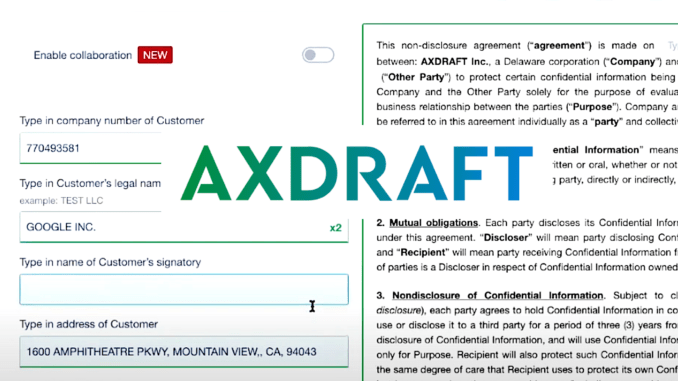
Meet Axdraft, a doc automation and CLM platform that has been experimenting with the new GPT-3 language model and plans to integrate applications built on the system into its offering.
First the core platform. Headquartered in New York, Axdraft provides a modular contract lifecycle management tool which incorporates document drafting automation, multi-step approval workflows, in-software collaboration with negotiation playbooks, and document storage with metadata tags and report generation.
Officially launched in 2017 and already with clients such as Carlsberg and Sandoz, Axdraft is now really limbering up and going to market after several years of building out the product. It joins an intensely competitive market segment with multiple new and old doc automation and CLM platforms fighting for market share. However, many corporates are not 100% wedded to any particular system yet and there is still much to play for.
Axdraft believes they have what it takes to break through. Terry Lesyk, Head of Business Development at the company, explained that one benefit they have is a team of legal engineers (i.e. people who work on doc automation)* who will take multiple versions of a contract for a client and build a single automated Q&A workflow for them.
Lesyk added that you can then move into the approval and negotiation phase once a doc is made, getting approvals at a document or clause level. You can invite counter-parties to also engage with the document inside the platform – but they won’t be able to see your red-lining or internal comments. You can also use a negotiation playbook, that for example an inhouse team has pre-set beforehand, which can include fall-back clauses.
Then there is the CLM aspect, with a storage facility with a tagging system. And there is more. You also get the feeling that Axdraft’s features are going to keep expanding – especially when one sees what they are doing with GPT-3 (see below).
Please see the AL TV product walk through below, which covers the main offering with a focus on the doc automation and then negotiation/approval phases. (9 mins – N.B. the GPT-3 aspects have not been added yet.)
AL TV Productions. Oct 2020.
And, as mentioned, the company has also been exploring what GPT-3 can do, which to put it simply is a natural language processing system that operates at more of an ‘idea’ level, rather than just a word or phrase level, when it comes to ‘understanding’ text, as well as generating new text.
As a result of holding their own hackathon in September, three fully functional features have been developed.
The company said: ‘This initiative not only defined Axdraft’s product development strategy, but also has unearthed a multitude of ways GPT-3 can augment the world of legal tech.’
Using primarily GPT-3’s basic text generation feature they developed additional applications that can be used for:
- Simplifying legal document clauses to plain English, which helps non-legal teams understand the content of the legal documents better.
- Extracting data from any document and using it to automatically populate Axdraft templates.
- Extracting a classifying metadata from any legal document, to simplify search and replace of information across contracts
Some of these features are already scheduled into the development backlog and ‘will soon be available for all Axdraft users’.
The company added that GPT-3 really is a game changer for them.
‘The fact that such solutions have been designed and programmed at very short notice and require little fine-tuning before users see them live, showcases the immense potential of GPT-3 technology for the legal industry.
‘Not only can it be employed by people with little to no coding experience, but also the flexibility of the technology allows us to cover diverse contract management scenarios, which is a big concern for companies with large document volumes and thousands of counteragents. Scaling GPT-3 is a huge leap towards automated legal review and more flexible document drafting.’
—
Here’s an overview of the platform’s key features (prior to any GPT-3 derived functions being added.)
- Document drafting automation engine based on customised question and answer workflow
- Collaborate, and negotiate on any document in-software (includes third-party document upload)
- Create multi-step dynamic approval flows at the document or clause level
- Search and store documents with metadata tags
- Generate reports based on contract metadata tags
- E-sign by Axdraft or connect preferred e-sign provider
- Turnkey setup and document automation by Axdraft.
–
(* Interesting that the term ‘legal engineer’ seems to be increasingly used to refer specifically to doc automation work, rather than for people working on legal tech projects in general.)